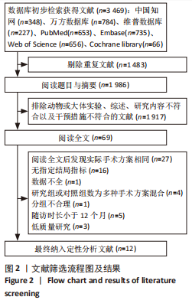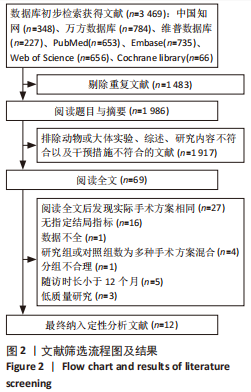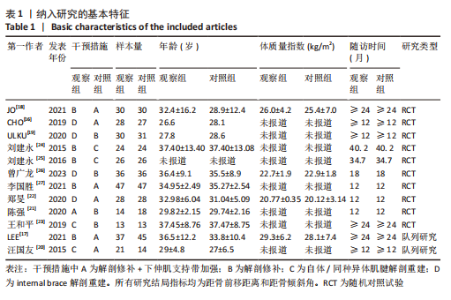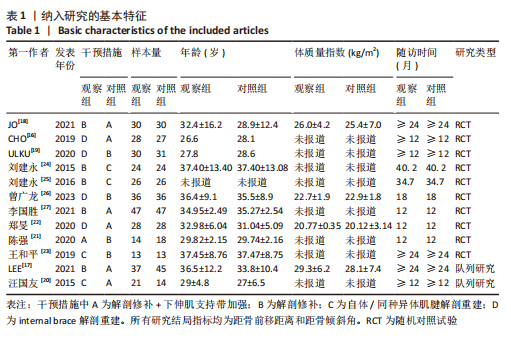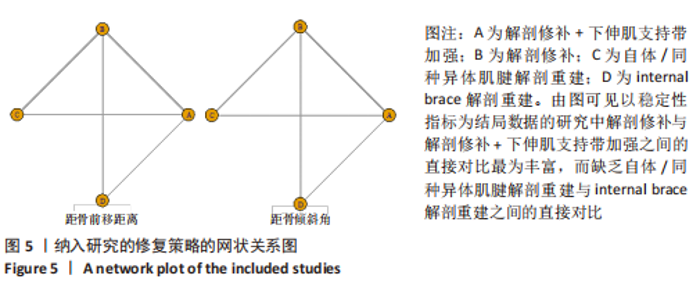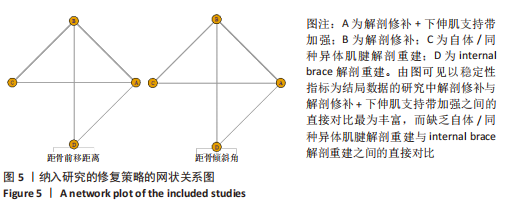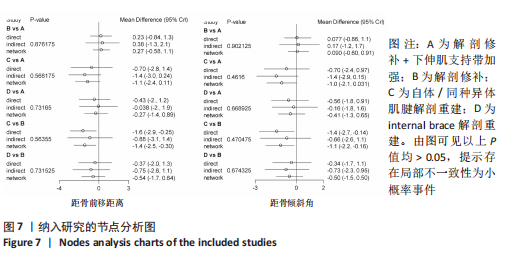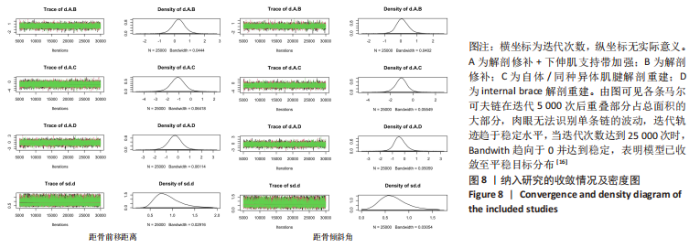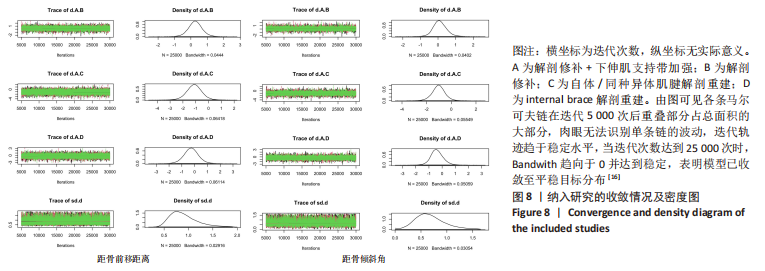Chinese Journal of Tissue Engineering Research ›› 2024, Vol. 28 ›› Issue (9): 1470-1476.doi: 10.12307/2023.910
Network meta-analysis of different anatomical repair strategies to improve chronic lateral ankle instability
Zhong Jun1, Wang Wen1, 2
- 1Guizhou Medical University, Guiyang 550025, Guizhou Province, China; 2Guangzhou Red Cross Hospital Affiliated to Jinan University, Guangzhou 510220, Guangdong Province, China
-
Received:2022-12-09Accepted:2023-02-04Online:2024-03-28Published:2023-07-26 -
Contact:Wang Wen, MD, Chief physician, Master’s supervisor, Guizhou Medical University, Guiyang 550025, Guizhou Province, China; Guangzhou Red Cross Hospital Affiliated to Jinan University, Guangzhou 510220, Guangdong Province, China -
About author:Zhong Jun, Master candidate, Guizhou Medical University, Guiyang 550025, Guizhou Province, China
CLC Number:
Cite this article
Zhong Jun, Wang Wen. Network meta-analysis of different anatomical repair strategies to improve chronic lateral ankle instability[J]. Chinese Journal of Tissue Engineering Research, 2024, 28(9): 1470-1476.
share this article
Add to citation manager EndNote|Reference Manager|ProCite|BibTeX|RefWorks

2.4.2 异质性及一致性检验结果 对纳入的12项研究运用传统Meta分析进行异质性检验,结果显示ATT与TTA方面的总体I2=88.7%,79.45%,显示异质性较高,故采用随机效应模型进行分析,见图6,分别拟合一致与不一致性模型,运用偏差信息准则(deriance information criterion,DIC)比较2种模型拟合结果的差异,可见2种模型的DIC均较大,且差异< 5,说明两者拟合程度相似,提示结果较为稳定,见表3,4,可使用一致性模型拟合。运用节点劈裂法(node-splitting method)检验局部不一致性,可见P > 0.05,表明各研究间局部不一致性可能小,因此在一致性模型下进行网状Meta分析,见图7。"
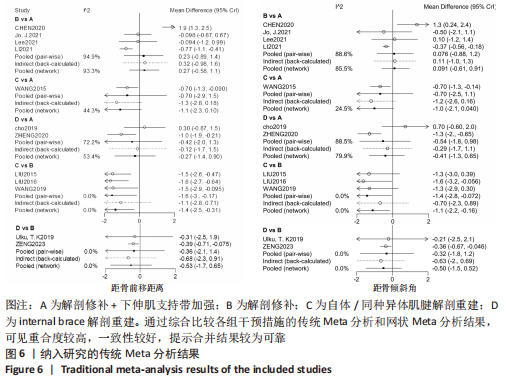

2.4.4 网状Meta分析结果 ①ATT方面:包括673例患者,自体/异体肌腱解剖重建优于解剖修补,差异有显著性意义[MD=-1.4,95%可信区间(-2.5,-0.3)不包括0],其余差异无显著性意义,见图10。SUCRA排序结果从劣到优排序为解剖修补(86%) > 解剖修补+IER加强(64%) > internal brace解剖重建(45%) > 自体/同种异体肌腱解剖重建(5%),见图11。②TTA方面:包括673例患者,自体/异体肌腱解剖重建优于解剖修补,差异有显著性意义[MD=-1.1,95%可信区间(-2.2,-0.15)不包括0],其余差异无显著性意义,见图10,SUCRA排序结果从劣到优排序为解剖修补(82%) > 解剖修补+IER加强(72%) > internal brace解剖重建(39%) > 自体/同种异体肌腱解剖重建(6%),见图11。"
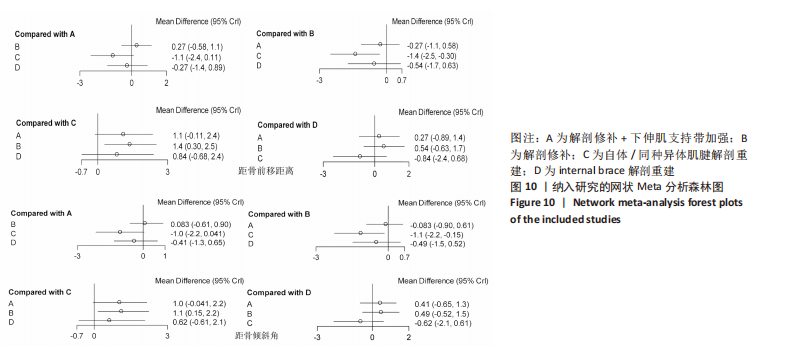
| [1] FEGER MA, GLAVIANO NR, DONOVAN L, et al. Current Trends in the Management of Lateral Ankle Sprain in the United States. Clin J Sport Med. 2017;27(2):145-152. [2] 徐柯烽,林平,涂迎春,等.踝关节镜下修复距腓前韧带治疗慢性踝关节不稳[J].中华关节外科杂志(电子版),2020,14(5): 636-639. [3] 魏合伟,郑维蓬,刘治军,等.氧化应激诱导肩袖肌腱干细胞自噬的表达[J].中国组织工程研究,2022,26(31):4954-4961. [4] WIJNHOUD EJ, RIKKEN QGH, DAHMEN J, et al. One in Three Patients With Chronic Lateral Ankle Instability Has a Cartilage Lesion. Am J Sports Med. 2022:3635465221084365. [5] CHOI YH, CHO SH, SEO J, et al. Apoptosis Occurs in the Anterior Talofibular Ligament of Patients With Chronic Lateral Ankle Instability: An In Vitro Study. Clin Orthop Relat Res. 2022;480(12):2420-2429. [6] XU Y, SONG B, MING A, et al. Chronic ankle instability modifies proximal lower extremity biomechanics during sports maneuvers that may increase the risk of ACL injury: A systematic review. Front Physiol. 2022;13:1036267. [7] XUE X, MA T, LI Q, et al. Chronic ankle instability is associated with proprioception deficits: A systematic review and meta-analysis. J Sport Health Sci. 2021;10(2):182-191. [8] DELAHUNT E, BLEAKLEY CM, BOSSARD DS, et al. Clinical assessment of acute lateral ankle sprain injuries (ROAST): 2019 consensus statement and recommendations of the International Ankle Consortium. Br J Sports Med. 2018;52(20):1304-1310. [9] LIN CC, LEE WC, CHEN JC, et al. The Influence of Kinesio Tape and an Ankle Brace on the Lower Extremity Joint Motion in Fatigued, Unstable Ankles during a Lateral Drop Landing. Int J Environ Res Public Health. 2021;18(11):6081. [10] YIN L, LIU K, LIU C, et al. Effect of Kinesiology Tape on Muscle Activation of Lower Extremity and Ankle Kinesthesia in Individuals With Unilateral Chronic Ankle Instability. Front Physiol. 2021;12:786584. [11] 王金杰,庄汝杰. Endobutton技术在慢性踝关节外侧不稳外侧韧带重建术中的应用[J].中医正骨,2021,33(5):71-73. [12] LEI T, QIAN H, LEI P, et al. Lateral augmentation reconstruction system versus modified Brostrom-Gould procedure: A meta-analysis of RCTs. Foot Ankle Surg. 2021; 27(3):263-270. [13] 曾宪涛,曹世义,孙凤,等.Meta分析系列之六:间接比较及网状分析[J].中国循证心血管医学杂志,2012,4(5):399-402. [14] 王巍巍,杨智荣,孙凤,等.网状Meta分析GRADE证据总结表的制订、解读与应用[J].中国循证医学杂志,2020,20(12):1471-1476. [15] 易跃雄,张蔚,刘小媛,等. 网状Meta分析图形结果解读[J].中国循证医学杂志,2015, 15(1):103-109. [16] CHO BK, PARK JK, CHOI SM, et al. A randomized comparison between lateral ligaments augmentation using suture-tape and modified Broström repair in young female patients with chronic ankle instability. Foot Ankle Surg. 2019; 25(2):137-142. [17] LEE SH, CHO HG, YANG JH. Additional Inferior Extensor Retinaculum Augmentation After All-Inside Arthroscopic Anterior Talofibular Ligament Repair for Chronic Ankle Instability Is Not Necessary. Am J Sports Med. 2021; 49(7):1721-1731. [18] JO J, LEE JW, KIM HJ, et al. Arthroscopic All-Inside Anterior Talofibular Ligament Repair with and without Inferior Extensor Retinacular Reinforcement: A Prospective Randomized Study. J Bone Joint Surg Am. 2021;103(17):1578-1587. [19] ULKU TK, KOCAOGLU B, TOK O, et al. Arthroscopic suture-tape internal bracing is safe as arthroscopic modified Broström repair in the treatment of chronic ankle instability. Knee Surg Sports Traumatol Arthrosc. 2020; 28(1):227-232. [20] 汪国友,徐平,曾胜强,等.关节镜辅助部分腓骨长肌重建踝关节外侧韧带的研究[J].足踝外科电子杂志,2015,2(2):1-5. [21] 陈强,刘丹,刘满建.关节镜下改良Brostrom术式治疗踝关节不稳的临床观察[J].医学理论与实践,2020,33(18):3043-3045. [22] 郑旻,黄伟杰,滕跃,等.关节镜下韧带增强固定与改良Brostrom术治疗慢性踝关节外侧不稳定的效果比较[J].临床外科杂志, 2020,28(4):319-323. [23] 王和平.距腓前韧带/跟腓韧带解剖重建与改良Brostrom法治疗慢性踝关节外侧不稳定对比观察[J].足踝外科电子杂志, 2019,6(2):51-53. [24] 刘建永,王英振,姜鑫.慢性踝关节外侧不稳定解剖重建与修复疗效的比较观察[J].中国矫形外科杂志,2015,23(18):1667-1672. [25] 刘建永.慢性踝关节外侧不稳定距腓前韧带和跟腓韧带解剖重建[J].中国运动医学杂志, 2016,35(2):126-131. [26] 曾广龙,谢庆祥,李泳聪,等.慢性踝关节外侧不稳全关节镜下距腓前韧带锚钉修复与可吸收免打结线带重建的比较[J].中国组织工程研究,2023,27(13):2064-2070. [27] 李国胜.全关节镜下锚钉修复对慢性踝关节不稳距腓前韧带损伤术后患者踝关节功能的影响[J].中国疗养医学,2021,30(3): 309-311. [28] MURPHY GA. The modified Broström techniquefor reconstruction of chronic lateral ankle instability. Oper Tech Sports Med. 1999; 7(1):36-40. [29] DALMAU-PASTOR M, MALAGELADA F, KERKHOFFS GMMJ, et al. X-shaped inferior extensor retinaculum and its doubtful use in the Bröstrom-Gould procedure. Knee Surg Sports Traumatol Arthrosc. 2018;26(7):2171-2176. [30] ZENG G, HU X, LIU W, et al. Open Broström-Gould Repair vs Arthroscopic Anatomical Repair of the Anterior Talofibular Ligament for Chronic Lateral Ankle Instability. Foot Ankle Int. 2020;41(1):44-49. [31] JEONG BO, KIM MS, SONG WJ, et al. Feasibility and outcome of inferior extensor retinaculum reinforcement in modified Broström procedures. Foot Ankle Int. 2014;35(11):1137-1142. [32] LI J, QI W, YUN X, et al. Comparison of Modified Broström Procedure with or without Suture Tape Augmentation Technique for the Chronic Lateral Ankle Instability. Biomed Res Int. 2022; 2022:6172280. [33] 徐又佳,沈光思,陈世益.人工韧带修复前交叉韧带的临床应用[J].中华创伤杂志, 2017,33(2):100-103. [34] 严浩,齐志明.纳米材料人工韧带骨连接及在抗粘连领域的研究与应用[J].中国组织工程研究,2021,25(16):2605-2611. [35] XU X, HU M, LIU J, et al. Minimally invasive reconstruction of the lateral ankle ligaments using semitendinosus autograft or tendon allograft. Foot Ankle Int. 2014;35(10):1015-1021. [36] LI Q, MA K, TAO H, et al. Clinical and magnetic resonance imaging assessment of anatomical lateral ankle ligament reconstruction: comparison of tendon allograft and autograft. Int Orthop. 2018;42(3):551-557. [37] 徐玥,李卫平,江川,等.关节镜下距腓前韧带联合跟腓韧带解剖重建术的临床疗效[J].中华骨科杂志,2019,39(11):667-674. [38] 王成伟,郭鹏超,王雪,等.同种异体肌腱及自体腓骨短肌重建踝关节外侧副韧带的比较[J].中国组织工程研究,2015,19(30): 4908-4914. [39] RUPP MC, DEGENHARDT H, WINKLER PW, et al. High return to sports and return to work rates after anatomic lateral ankle ligament reconstruction with tendon autograft for isolated chronic lateral ankle instability. Knee Surg Sports Traumatol Arthrosc. 2022; 30(11):3862-3870. [40] ZHI X, ZHANG Y, LI W, et al. Absorbable suture anchor and knotless anchor techniques produced similar outcomes in arthroscopic anterior talofibular ligament repair. Knee Surg Sports Traumatol Arthrosc. 2022;30(6):2158-2165. [41] YANG KC, CHEN PY, LOH C, et al. Chronic Lateral Ankle Instability Treated With Tendon Allografting: A Preliminary Comparison of Arthroscopic and Open Anatomic Ligament Reconstruction. Orthop J Sports Med. 2022;10(10):23259671221126693. [42] SONG YJ, HUA YH. Similar Outcomes at Early Term After Arthroscopic or Open Repair of Chronic Ankle Instability: A Systematic Review and Meta-Analysis. J Foot Ankle Surg. 2019;58(2):312-319. |
| [1] | Zhang Xiaoyun, Liu Hua, Chai Yuan, Chen Feng, Zeng Hao, Gao Zhengang, Huang Yourong. Effect of Yishen Gushu Formula on bone metabolic markers and clinical efficacyn in patients with osteoporosis of kidney deficiency and blood stasis type [J]. Chinese Journal of Tissue Engineering Research, 2024, 28(8): 1155-1160. |
| [2] | Hu Zhixing, Li Qun, Yang Chao, Wang Xiaoxiao, Fang Luochangting, Hou Wuqiong, Lin Na, Chen Weiheng, Liu Chunfang, Lin Ya. Network meta-analysis of the modeling effects of different factors on rabbit models of steroid-induced osteonecrosis of femoral head [J]. Chinese Journal of Tissue Engineering Research, 2024, 28(6): 976-984. |
| [3] | Chang Wanpeng, Zhang Zhongwen, Yang Yulin, Zi Yang, Yang Mengqi, Du Bingyu, Wang Nan, Yu Shaohong. Efficacy of rehabilitation exoskeleton robots on post-stroke lower limb motor dysfunction: a Meta-analysis [J]. Chinese Journal of Tissue Engineering Research, 2024, 28(2): 321-328. |
| [4] | Jiang Xiaocheng, Shi Lu, Wang Yinbin, Li Qiujiang, Xi Chuangzhen, Ma Zefeng, Cai Lijun. Systematical evaluation of bone fusion rate after interbody fusion in patients with osteoporosis and lumbar degenerative disease treated with teriparatide [J]. Chinese Journal of Tissue Engineering Research, 2023, 27(9): 1427-1433. |
| [5] | Yang Jiujie, Li Zhi, Wang Shujie, Tian Ye, Zhao Wei. Intraoperative neurophysiological monitoring of functional changes following durotomy with decompression for acute spinal cord injury [J]. Chinese Journal of Tissue Engineering Research, 2023, 27(8): 1232-1236. |
| [6] | Li Wenjie, You Aijia, Zhou Junli, Fang Sujuan, Li Chun. Effects of different dressings in the treatment of burn wounds: a network meta-analysis [J]. Chinese Journal of Tissue Engineering Research, 2023, 27(7): 1141-1148. |
| [7] | Chen Peng, Wang Ling, Dong Shiyu, Ding Yue, Jia Shaohui, Kou Xianjuan, Zheng Cheng. Effects of whole-body vibration training on anterior cruciate ligament reconstruction: a meta-analysis [J]. Chinese Journal of Tissue Engineering Research, 2023, 27(36): 5875-5883. |
| [8] | Wang Zhenyu, Xia Yuan, Lu Yue, Pan Xinyong, Li Yongjie. Effects of different resistance training programs on bone mineral density in postmenopausal women: a network Meta-analysis [J]. Chinese Journal of Tissue Engineering Research, 2023, 27(28): 4586-4592. |
| [9] | Yin Yikun, Wang Jialin, Sun Junzhi. Therapeutic effect of different-frequency repetitive transcranial magnetic stimulations on post-stroke cognitive impairment: a Meta-analysis [J]. Chinese Journal of Tissue Engineering Research, 2023, 27(20): 3274-3280. |
| [10] | Wang Suping, Qiu Demei, Fan Zhonghe, Hu Bo. Bibliometrics and visual analysis of research in the field of rehabilitation for femoroacetabular impingement syndrome in the past decade [J]. Chinese Journal of Tissue Engineering Research, 2023, 27(17): 2754-2762. |
| [11] | Peng Tuanhui, Yang Ling, Ding Xiaoge, Meng Pengjun. A systematic review and meta-analysis of the effects of long-term exercise on blood lipids in healthy elderly people [J]. Chinese Journal of Tissue Engineering Research, 2023, 27(14): 2276-2282. |
| [12] | Zeng Guanglong, Xie Qingxiang, Li Yongcong, Su Boyuan. All-arthroscopic repair of anterior talofibular ligament with suture anchors versus InternalBrace for chronic lateral ankle instability [J]. Chinese Journal of Tissue Engineering Research, 2023, 27(13): 2064-2070. |
| [13] | Jing Jinpeng, Zhang Yue, Liu Xiaomin, Liu Yi. Traditional Chinese medicine injection for promoting blood circulation in prevention of deep vein thrombosis after orthopedic surgery: network meta-analysis [J]. Chinese Journal of Tissue Engineering Research, 2022, 26(9): 1467-1476. |
| [14] | Liu Gang, Ma Chao, Wang Le, Zeng Jie, Jiao Yong, Zhao Yi, Ren Jingpei, Hu Chuanyu, Xu Lin, Mu Xiaohong. Ankle-foot orthoses improve motor function of children with cerebral palsy: a Meta-analysis based on 12 randomized controlled trials [J]. Chinese Journal of Tissue Engineering Research, 2022, 26(8): 1299-1304. |
| [15] | Wang Nan, Qian Yuzhang, Xie Lin. Network Meta-analysis of different acupuncture methods for the treatment of lumbar disc herniation [J]. Chinese Journal of Tissue Engineering Research, 2022, 26(5): 813-820. |
| Viewed | ||||||
|
Full text |
|
|||||
|
Abstract |
|
|||||
